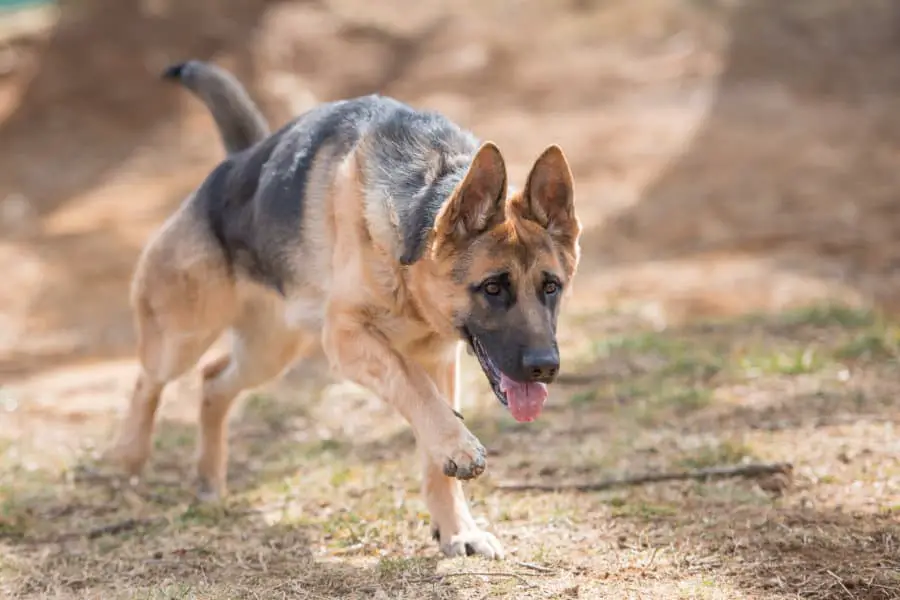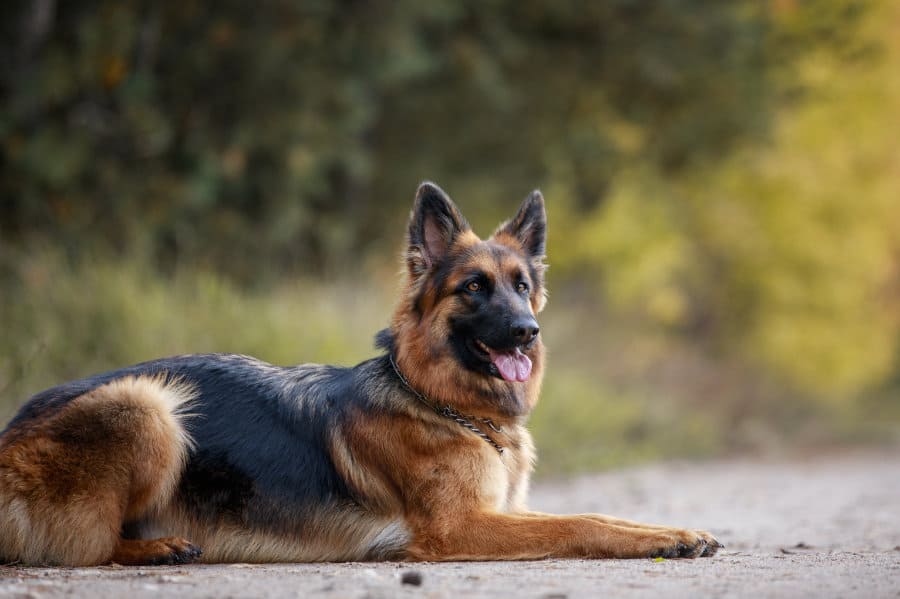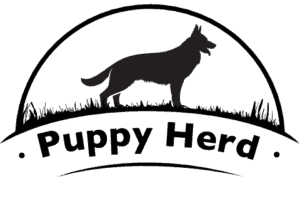There is a lot of controversy about the ideal weight for German Shepherd Dogs (GSDs). There may be some controversy between owners that show their dogs and owners of working dogs. The show dogs are often kept at a higher weight than working dogs. Then there is the regular household German Shepherd pet, and owners of these dogs may be unsure of the correct weight for these dogs. A German Shepherd’s ideal weight is usually based on a body condition score. One of the factors in scoring body condition is whether a dog’s ribs are showing.
You should not be able to see the ribs of a German Shepherd Dog. If you see the ribs showing, then the dog is underweight. You should easily feel the ribs and spine when you touch the dog, but this must also not be exaggerated. There must be a clearly defined waist.
German Shepherds are large, powerful dogs that sometimes struggle to keep their weight up, especially in young dogs. Some owners are afraid of potential joint problems and tend to keep their German Shepherds too thin to remove pressure from the joints. this article will give you information on scoring your dog’s body condition, and the correct feeding protocols for German Shepherds and possible problems that you may encounter.

Is Your German Shepherd Dog Too Skinny?
German Shepherds often have relatively thick coats. If you can see the ribs showing, then your dog is severely underweight. It can be challenging to assess the dog’s body condition from a visual inspection alone. It is important to use your sense of touch to evaluate the dog. You need to feel along the ribs and spine and compare this to a body conditioning chart. Body conditioning charts are designed to help you be more objective about assessing your German Shepherd’s weight.
On average, an adult German Shepherd should weigh between 50-90 lbs., though healthy full-grown females can weigh in between 50-70 lbs., and healthy males between 65-90 lbs.
German Shepherd breed clubs or national kennel associations may provide guidelines on the weight of male and female German Shepherds in pounds or kilograms. It is crucial to remember that these are only theoretical guidelines and not absolute rules. Each dog is an individual with its own bone structure and conformation. These individual variations are why it is best to use a body conditioning chart. If you are unsure of assessing your dog’s body condition, you can ask for help from a veterinarian or vet technician.
Body Conditioning Charts
There are many body conditioning charts and scoring systems available, and they each have their own numbering system. Dog breeds have different shapes. You could not expect a bulldog or chihuahua to look the same as a German Shepherd. When you are choosing a body conditioning scoring system, it is a good idea to choose one that allows you to adjust the system based on your dog’s breed.
A sound body conditioning assessment system that makes allowances for the breed of dog is the Royal Canin Body Condition Score. You can see the Royal Canin system in its German Shepherd adaptation by clicking here. On this scoring system, the ideal score for a German Shepherd is 5. This score indicates that the ribs may be felt but not seen. There is no excess fat covering the ribs. It gives you a side and top view of a German Shepherd so that you can see how the waist should be clearly defined and the abdomen tucked up as it enters the pelvic region. The waist must not, however, look excessively pinched in.
Many owners incorrectly estimate their dog’s weight on body charts up to thirty percent of the time. It is essential to be realistic and objective. Most veterinarian practices run weight clinics where you can be assisted to determine your dog’s body condition without having to pay full consultation fees. Some practices even offer this as a free service.

Underweight German Shepherds
German Shepherds are highly active dogs that tend only to slow down as they reach old age. This activity and the fact that they may have a high metabolic rate result in dogs that are commonly underweight. In addition, German Shepherds of some genetic lines are known for having food allergies or sensitive gastrointestinal systems. Veterinarians even sometimes call the disorder “German Shepherd stomach” to indicate the common troublesome of the German Shepherd’s gastrointestinal system. These conditions can make it difficult to bulk up your German Shepherd.
How To Increase Your German Shepherd’s Weight
The best method to increase the weight of your German Shepherd is to feed a diet that is high in protein and fats. It is important to note that animal proteins and fats are the best ingredients for adding weight. Plant proteins and fats usually come from legumes such as soya, peas, and beans. These can be troublesome in the German Shepherd’s stomach, and legumes are a common allergen. German Shepherds are one of the breeds prone to bloat and torsion, a deadly condition that can kill dogs in a short time. Legumes produce a lot of gas, and so it is best to avoid these plant proteins and fats in your dog’s diet.
Some German Shepherds may be allergic to specific animal proteins. These are usually commonly encountered proteins such as chicken or pork. In these instances, the dog can be fed a novel protein such as duck or rabbit. When adding weight, you should provide thirty to fifty percent protein and twenty to thirty percent fat.
The rest of the dietary calories can be made up of carbohydrates. If your dog has nutritional allergies, it is best to stick to vegetable carbohydrates. Many dogs are allergic to grains and cannot tolerate maize, wheat, or rice. Sweet potato and vegetables of the squash family add carbohydrates and fiber, which are beneficial in a dog’s diet. Dogs are seldom allergic to these vegetables.

Managing An Overweight Dog
There are several theories on the most efficient way to diet overweight German Shepherds. It is important to remember that these are probably senior dogs that are less active, and their metabolism has slowed down. Sometimes the dog is overweight because the owner was used to feeding an active dog with a high metabolic rate. The owner did not adjust to the dog’s aging process. The first task should be to check the portion size and calorie content of the food you are feeding your dog.
Slowly decrease the portion size so that your German Shepherd learns to eat smaller meals. The gradual decrease helps your dog become accustomed to the smaller meals without starving because his meals are suddenly reduced. If you feed high-performance food for working dogs or puppy food, change this to senior food. The overweight dog needs a much smaller fat percentage in his diet. Vegetables can help provide bulky fiber so that the dog does not feel as hungry while his proteins and fats are reducing.
Final Thoughts
You should not be able to see a German Shepherd’s ribs. You should be able to feel them, but they should not be easily visible. Your German Shepherd should have a clearly defined waist. Use a body conditioning system to assess your dog to determine if they are at their ideal weight. Make use of veterinary dietary clinics to help boost or reduce your dog’s weight. Learn to read dog food packaging to assess the ingredients and the division of proteins, carbohydrates, and fats. You should evaluate your dog’s weight regularly to ensure that you maintain your dog at the correct weight. It is a practical means of monitoring your dog’s health. A dog that suddenly loses or gains weight can be the first indication of a health problem.
